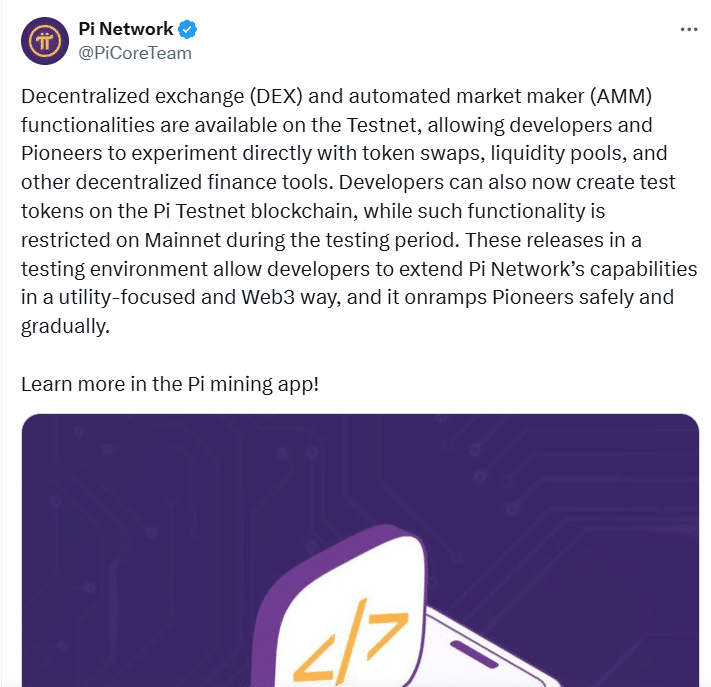Will Pi’s New DEX and AMM Finally Silence the Critics?
Pi Network has taken another step in its cautious but calculated journey toward mainstream adoption. The project recently introduced a decentralized exchange (DEX) and automated market maker (AMM) on its testnet, a move that allows its vast community to interact with decentralized finance features in a controlled environment.
The development, paired with new support for token creation on testnet, has sparked conversations about whether Pi is finally ready to pivot from a community-building experiment to a serious contender in the DeFi space.
Pi Network Brings DeFi Tools to Testnet
The rollout enables developers and Pioneers to experiment with liquidity pools, swaps, and token issuance, hallmarks of DeFi ecosystems. By keeping these functions on testnet, Pi Network reduces risk while encouraging community participation. Dr. Chengdiao Fan, Pi’s cofounder, emphasized during the TOKEN2049 event that “features like DEX and AMM will remain in testnet until governance, security, and utility measures are fully tested.”
This careful approach mirrors strategies seen in traditional finance, where pilot projects often precede full-scale deployment. For Pi, which claims tens of millions of engaged users, the testnet launch is less about short-term hype and more about laying the foundation for real utility.
Balancing Utility and Speculation
One of the strongest criticisms Pi has faced is the lack of genuine utility beyond its mobile mining app. The launch of a testnet DEX and AMM directly addresses this by offering tangible tools for users and developers. Analysts note that while Pi has not yet bridged to major trading venues, these experiments can help the ecosystem grow organically.
Community reactions have been divided. Some Pioneers see this as proof that the project is moving toward substance. Others remain cautious, pointing out that testnet success doesn’t always translate to mainnet traction.
 Source: X
Source: X
On X, one community developer wrote, “DEX is fun to test, but the real impact comes only when Pi tokens are live in mainnet liquidity pools.” The statement reflects both optimism and realism, a balance the project must manage carefully.
Market Implications and Early Indicators
Price watchers link the announcement to recent stability in PI Network’s market behavior. Trading data shows the token hovering near $0.27, holding a support zone despite broader market volatility. If Pi leverages its DeFi tools successfully, analysts suggest it could drive sustained demand rather than fleeting speculation.
At the same time, risks remain. Token concentration among a small number of wallets, potential supply shocks from future unlocks, and uncertainty about regulatory positioning create hurdles. However, compared with meme-driven projects that often implode under scrutiny, Pi network appears intent on building layer by layer.
A Slow but Strategic Road Ahead
The introduction of DEX and AMM on testnet underscores Pi’s philosophy: move slowly, involve the community, and test before scaling. If Pi can convert testnet lessons into mainnet resilience, it may emerge as a unique hybrid, part grassroots social experiment, part serious DeFi contender.
As one industry analyst remarked, “The DeFi space doesn’t need another flashy token; it needs projects that can scale utility safely. Pi’s testnet launch is a step in that direction.”
Conclusion
Pi Network’s decision to release DeFi tools on testnet is more than a technical milestone, it’s a statement of intent. By offering token creation, swaps, and liquidity pools in a safe environment, Pi shows it is serious about utility and community engagement.
Whether this step translates into real adoption depends on how well the project handles governance, demand, and eventual mainnet integration. For now, the experiment is underway, and all eyes are on Pi to see if it can transform hype into lasting impact.
FAQs
Q1: What did Pi Network recently launch?
Pi Network introduced a decentralized exchange (DEX) and automated market maker (AMM) on its testnet, along with token creation support.
Q2: Why is this launch significant?
It moves Pi closer to real-world utility, allowing developers and users to engage with DeFi features before they roll out on mainnet.
Q3: How has the community reacted?
Reactions are mixed. Some praise the move as progress, while others argue the real test will come with mainnet implementation.
Q4: What risks should investors consider?
Risks include token concentration in large wallets, regulatory challenges, and uncertainty about whether testnet experiments will scale.
Glossary of Key Terms
DEX (Decentralized Exchange): A platform for peer-to-peer crypto trading without intermediaries.
AMM (Automated Market Maker): A system that uses liquidity pools instead of traditional order books to enable trading.
Testnet: A blockchain environment for testing features without risking real assets.
Liquidity Pool: A pool of crypto tokens locked in a smart contract to facilitate trading.
Token Unlock: The release of previously restricted tokens into circulation, often creating price pressure.
Mainnet: The fully launched blockchain network where real transactions and tokens exist.
Read More: Will Pi’s New DEX and AMM Finally Silence the Critics?">Will Pi’s New DEX and AMM Finally Silence the Critics?
You May Also Like

Botanix launches stBTC to deliver Bitcoin-native yield

SEC clears framework for fast-tracked crypto ETF listings
